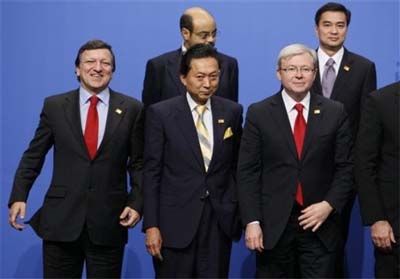This is, of course, a pointed reference to the common criticism made about Okada himself (for which he makes no apologies, rationalising that it is an advantage to stick to a firm policy line). It is significant, however, that the Obama administration has backed down from its earlier hard-line stance that earlier agreements with the LDP administration regarding US force restructuring in Japan (including the Futenma issue). It’s also fortunate that Okada is an old mate of Kurt Campbell’s, who appears more flexible. The Americans are being realistic – it would be impossible for the United States to engage in this process without Japanese cooperation. What will be vitally important, however, is what will happen under a DPJ administration with respect to US-Japan military cooperation, including the sharing of key bases. Will this proceed on the expansionary course set by previous LDP administrations? This is the ‘nuts and bolts’ end of the US-Japan alliance and is a key indicator of how close both sides envision their militaries acting together to meet threats. It will also be worth keeping an eye on what Japan and US agree to as ‘shared strategic objectives’ down the track.
Tobias says: ‘Obama singled out Hatoyama for praise for “running an extraordinary campaign and his party leading dramatic change in Japan.”’
Obama obviously feels some affinity with Hatoyama and the quiet revolution that the DPJ has achieved in Japan, given that it is no less a singular political achievement than Obama’s. In my view the ‘yes we can’ mentality really resonated with Japanese voters and spurred them into thinking that they could really achieve ‘regime change’.
Tobias Harris says: ‘the real story is not the distant dream of an East Asia integrated like the EU but the prospects for partnership between Hatoyama and the leaders of East Asia’s other middle powers, symbolized by the exchange between Hatoyama and Rudd.’
PM Hatoyama’s idea is that an Asia Pacific Community (akin to PM Rudd’s idea), which would involve the US, should only be pursued after the East Asia community (EAC) has been established. The DPJ’s plan to create an EAC has Japan-China relations as its core (as a kind of joint leadership of East Asia – bigemony?), so would include more than just so-called ‘middle powers’, but would not include the US. On these grounds, it seems that PM Hatoyama is prioritising East Asia, not the Asia-Pacific, as the centre of multilateralist diplomacy in the region.
Tobias Harris says: ‘an East Asian community that includes all the countries that participate in the East Asian Summit…’
Under PM Koizumi, the first East Asia Summit (EAS) held in 2005 in Kuala Lumpur was ASEAN+3+3, namely ASEAN+6, with India included along with Australia and New Zealand (as US allies) in order to dilute China’s influence. While the quadrilateral might be defunct as an embryonic strategic alliance/containment coalition against China (note, though, that Japan continues to participate in the India-led trilateral Exercise Malabar, which was held off Okinawa this year), the question is whether this framework is the one envisioned by the Hatoyama administration as the model for an EAC. I’m not sure Hatoyama’s EAC will include India.
Tobias Harris says: ‘I have also noted the affinities between Fukuda and Hatoyama when it comes to Asia.’
This is true in one sense (the Fukuda Doctrine revisited and all that). However, first, as he outlined it at the International Conference on the Future of Asia in Tokyo in May 2008, PM Fukuda’s vision of the Pacific Ocean as an ‘inland sea’ was much, much broader than what PM Hatoyama has in mind (it stretched in Fukuda’s imagination to include not only Russia, North and South America, but also India and the Middle East!). Second, PM Fukuda was big on the idea of ‘synthesis’: promoting Japan’s Asia diplomacy, but also, at the same time, strengthening the Japan-US alliance as two equally important priorities (the latter goal does not quite fit with what the Hatoyama has in mind with respect to Japan’s relations with the US, although it might be an outcome of the new administration’s plans for revising the alliance).
The general point being made here is that the new Hatoyama administration is engineering a whole series of subtle shifts in Japanese external policies, and these shifts can only be found by putting them under the microscope and comparing them with past LDP policies. It’s as if Hatoyama is steering a supertanker, where slight shifts in headings result in quite dramatic mid- to long-term changes of direction.

